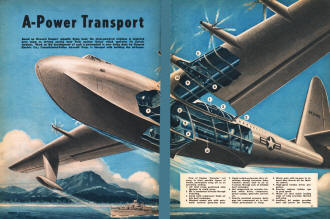|
Atomic-powered aircraft was another
dream of mid-last-century visionaries. It was the post World War II era where, following
the demonstration of nuclear energy's awesome capacity demonstrated in Japan, plans were
being made to harness its capacity for peaceful uses. Large scale atomic
power electricity and steam generation stations were being designed and built. So, too,
were personal nuclear power packs, atomic-powered car, boats, submarines, airplanes,
rockets, and trains envisioned. Unfortunately, designers soon learned that safe
containment of the fuel made small form factor generators impractical. America's first nuclear power station,
Shippingport Atomic Power Station in Pennsylvania, came online in
1957. Unfortunately, a few accidents in power stations has spooked the public into rejecting
what is presently the only pollution-free, compact option for electric power generation.
Photovoltaic array and wind turbine farms are not pollution-free in their manufacturing
and construction, and disturb huge amounts of wildlife and land. We still hold out
hope for nuclear fusion electric power generators (the
tokamak).
A-Power Transport
 Based on Howard Hughes' gigantic flying boat,
the atom-powered airplane is depicted here using as driving energy heat from nuclear
fission which operates its hot-air turbines. Work on the development of such a powerplant
is now being done by General Electric Co.; Consolidated-Vultee Aircraft Corp. is charged
with building the airframe. Based on Howard Hughes' gigantic flying boat,
the atom-powered airplane is depicted here using as driving energy heat from nuclear
fission which operates its hot-air turbines. Work on the development of such a powerplant
is now being done by General Electric Co.; Consolidated-Vultee Aircraft Corp. is charged
with building the airframe.
View of Hughes "Hercules" cut away to show possible layout of atomic powerplant using
air as an operating medium.
Features:
1. Air inlet scoop positioned atop fuselage to avoid spray.
2. Air is conducted forward through U-ducting.
3. Large axial compressor feeds air into heat exchanger.
4. Shielded atomic pile with automatic controls generates heat.
5. Liquid sodium-potassium alloy circulating through zirconium tubes transfers
atomic heat to air as it passes through coils of shielded heat exchanger.
6. Hot compressed air actuates turbine which drives compressor, powers
pumps, generates current, etc.
7. Heavily insulated pressure ducts pipe hot compressed air to individual
powerplants in wings.
8. Waste fate with by-pass to exhaust duct diverts air for throttle control.
9. High-speed turbine drives propellers.
110. Gearing reduces turbine rpm to prop speed.
11. Waste air duct inside leading edge of wing provides thermal anti-icing
12. Auxiliary jet engine provides heat and power for starting.
Posted June 23, 2018
|



